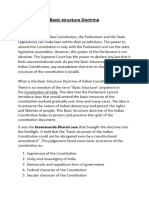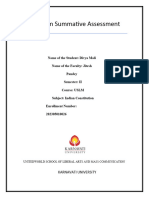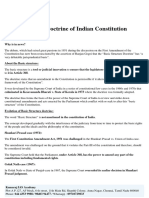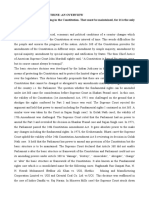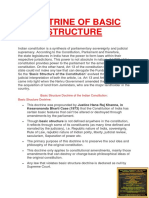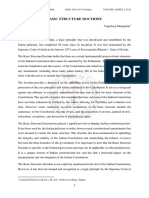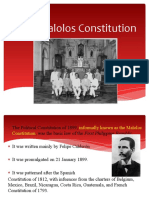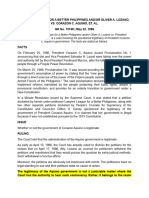Doctrine of Basic Structure in the Indian Constitution
The Doctrine of Basic Structure is a cornerstone of Indian constitutional law,
established and developed through a series of landmark judgments. Below is the
chronological sequence of key cases associated with the evolution of this doctrine:
1. Sankari Prasad v. Union of India (1951)
- Issue: Challenged the validity of the First Constitutional Amendment.
- Verdict: The Supreme Court upheld the amendment, stating that Parliament had the power
to amend any part of the Constitution, including Fundamental Rights.
2. Sajjan Singh v. State of Rajasthan (1965)
- Issue: Challenged the validity of the Seventeenth Amendment.
- Verdict: The Court reaffirmed the view in Sankari Prasad and upheld Parliament's
power to amend the Constitution.
3. Golaknath v. State of Punjab (1967)
- Issue: Whether Parliament could amend Fundamental Rights.
- Verdict: The Court held that Fundamental Rights are immutable and cannot be
amended by Parliament, limiting its powers under Article 368.
4. Kesavananda Bharati v. State of Kerala (1973)
- Significance: The Doctrine of Basic Structure was established.
- Verdict: The Supreme Court ruled that while Parliament has wide powers to amend
the Constitution, it cannot alter the basic structure or fundamental framework
of the Constitution.
�5. Indira Nehru Gandhi v. Raj Narain (1975)
- Issue: Constitutional validity of the Thirty-ninth Amendment, which sought to immunize
the Prime Minister's election from judicial review.
- Verdict: The Court invalidated the amendment, holding that free and fair elections
form part of the basic structure.
6. Minerva Mills v. Union of India (1980)
- Issue: The Forty-second Amendment, which sought to limit judicial review.
- Verdict: The Court reaffirmed the basic structure doctrine, emphasizing that judicial
review and balance between Fundamental Rights and Directive Principles of State Policy
are part of the basic structure.
7. Waman Rao v. Union of India (1981)
- Issue: Validity of laws placed in the Ninth Schedule before and after Kesavananda Bharati.
- Verdict: The Court held that amendments made to the Constitution after April 24, 1973
(Kesavananda judgment date), are subject to judicial review if they violate the
basic structure.
8. L. Chandra Kumar v. Union of India (1997)
- Issue: Jurisdiction of administrative tribunals and judicial review.
- Verdict: The Court ruled that judicial review by the High Courts and Supreme Court is a
basic feature of the Constitution and cannot be excluded.
9. I.R. Coelho v. State of Tamil Nadu (2007)
- Issue: Laws placed in the Ninth Schedule after Kesavananda Bharati.
- Verdict: The Court held that even laws placed in the Ninth Schedule after 1973 are
� subject to judicial review if they violate the basic structure.
10. NJAC Case (2015)
- Issue: Constitutionality of the Ninety-ninth Amendment and the National Judicial
Appointments Commission.
- Verdict: The Court struck down the amendment, holding that judicial independence is
part of the basic structure.
Summary of Basic Structure Components:
1. Supremacy of the Constitution
2. Separation of powers
3. Rule of law
4. Judicial review
5. Secularism
6. Democracy and free elections
7. Federalism
8. Independence of the judiciary
9. Parliamentary system of governance

